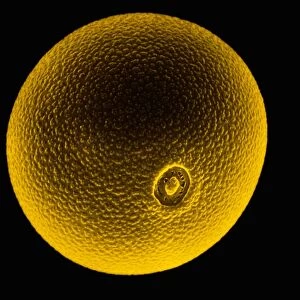Home > Science > SEM
Pollen grains of Cocksfoot grass
![]()

Wall Art and Photo Gifts from Science Photo Library
Pollen grains of Cocksfoot grass
False-colour scanning electron micrograph (SEM) of two pollen grains of cocksfoot grass, Dactylis glomerata. The pit on the right-hand grain is the germination pore, out which the pollen tube grows. Cocksfoot pollen is a wind- dispersed summer pollen & a major cause of hay fever (Allergic rhinitis or pollenosis). Sufferers produce a sensitising antibody, immunoglobin E (IgE), which attaches to cells in the nose & eyes. It reacts with inhaled pollen, causing the release of various chemicals including histamine. Histamine causes the mucous membranes of the nose, eyes & throat to swell & become inflamed, bringing on the symptoms of hay fever. Magnification: x370 at 35mm size. Gold tint. Original is bw print B786/073 Ref: MICROCOSMOS, fig. 4.32, p. 82
Science Photo Library features Science and Medical images including photos and illustrations
Media ID 6287917
© DR JEREMY BURGESS/SCIENCE PHOTO LIBRARY
Allergy Cocksfoot Grass Dactylis Glomerata Grass Hay Fever Pollen Re Production Reproductive Type Cocks Foot
EDITORS COMMENTS
This print showcases the intricate beauty of pollen grains from Cocksfoot grass, scientifically known as Dactylis glomerata. Through a false-color scanning electron micrograph (SEM), two pollen grains are depicted in stunning detail. The grain on the right exhibits a germination pore, which serves as an exit point for the emerging pollen tube. Cocksfoot grass is notorious for its wind-dispersed summer pollen, making it a significant contributor to hay fever or allergic rhinitis. Individuals suffering from this condition produce immunoglobin E (IgE), a sensitizing antibody that attaches to cells in the nose and eyes. Upon inhalation of cock's foot pollen, IgE triggers the release of various chemicals including histamine. Histamine plays a pivotal role in causing inflammation and swelling of mucous membranes in the nose, eyes, and throat – hallmark symptoms of hay fever. This microscopic image offers insight into how such tiny particles can have such profound effects on human health. Magnified at 370 times its original size with a gold tint added for visual appeal, this photograph provides an opportunity to appreciate nature's intricacies while shedding light on an important aspect of plant reproduction and human allergies. It is part of Science Photo Library's collection titled "MICROCOSMOS" and can be found on page 82 under figure 4.32.
MADE IN AUSTRALIA
Safe Shipping with 30 Day Money Back Guarantee
FREE PERSONALISATION*
We are proud to offer a range of customisation features including Personalised Captions, Color Filters and Picture Zoom Tools
SECURE PAYMENTS
We happily accept a wide range of payment options so you can pay for the things you need in the way that is most convenient for you
* Options may vary by product and licensing agreement. Zoomed Pictures can be adjusted in the Cart.



